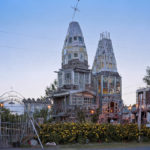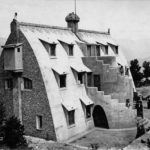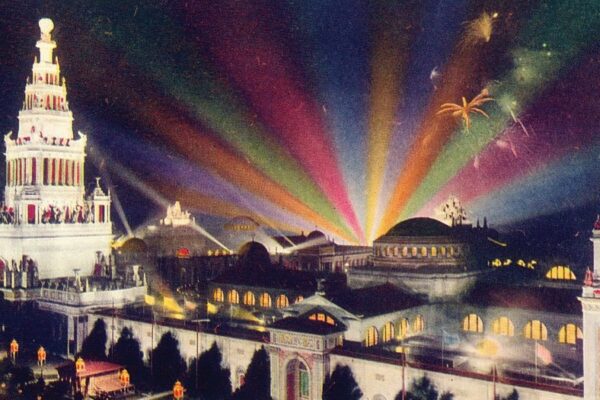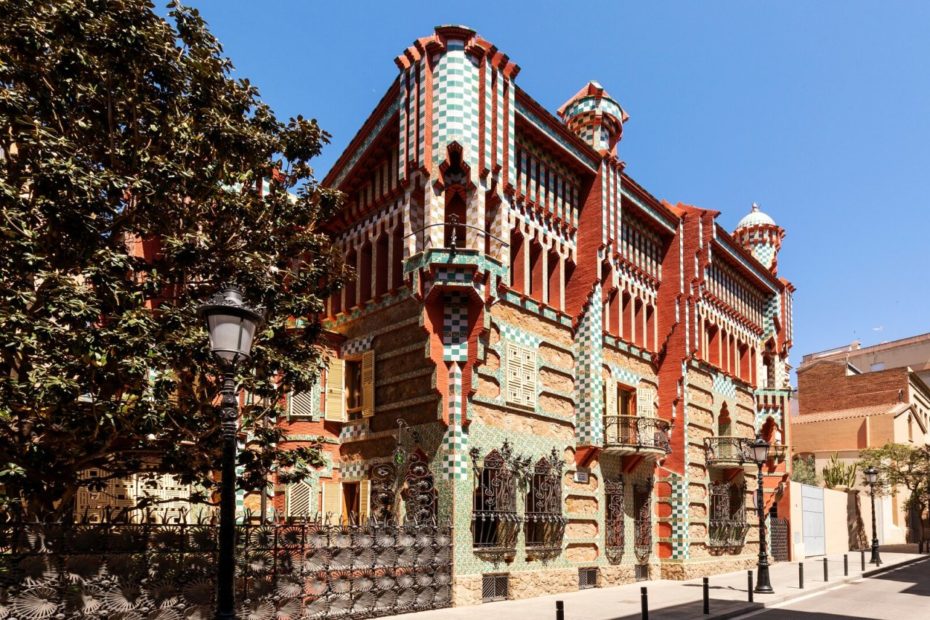
The art and science of the enclosure of space is all around us, shelter-creation being traditionally its key function but oftentimes architecture is also a mouthpiece for broadcasting a message through carefully crafted iconography. So-called ‘alternative’ structures vary from intellectual triumphs of the unconventional to purely attention-seeking visual bubble gum. It’s often somewhere in the middle of this spectrum of oddness that one finds the gems with merit amongst the irregular, the atypical and the absurd. These are the marvels that challenge our somewhat conventional tastes, that give us food for thought and toss us well and truly out of our comfort orbits. Throughout the ages our built havens – no matter how lavish or modest – have been vehicles of self-expression and where most of us opt for the polite and sensible, a handful dare to go beyond the mundane and the ordinary, gifting the world anything from exotic baroque palaces to shiny tin-can castles, all peddling a message. Hooray to these brave creators who dare to be different: those who build from the heart, those who sculpt with passion and those who paint with light to enrich our experiences.
Be prepared to park your preconceived ideas of what a structure should be and allow yourself to be fully immersed in the sensory rollercoaster you’re about to board…
1. Casa Vicens, Barcelona
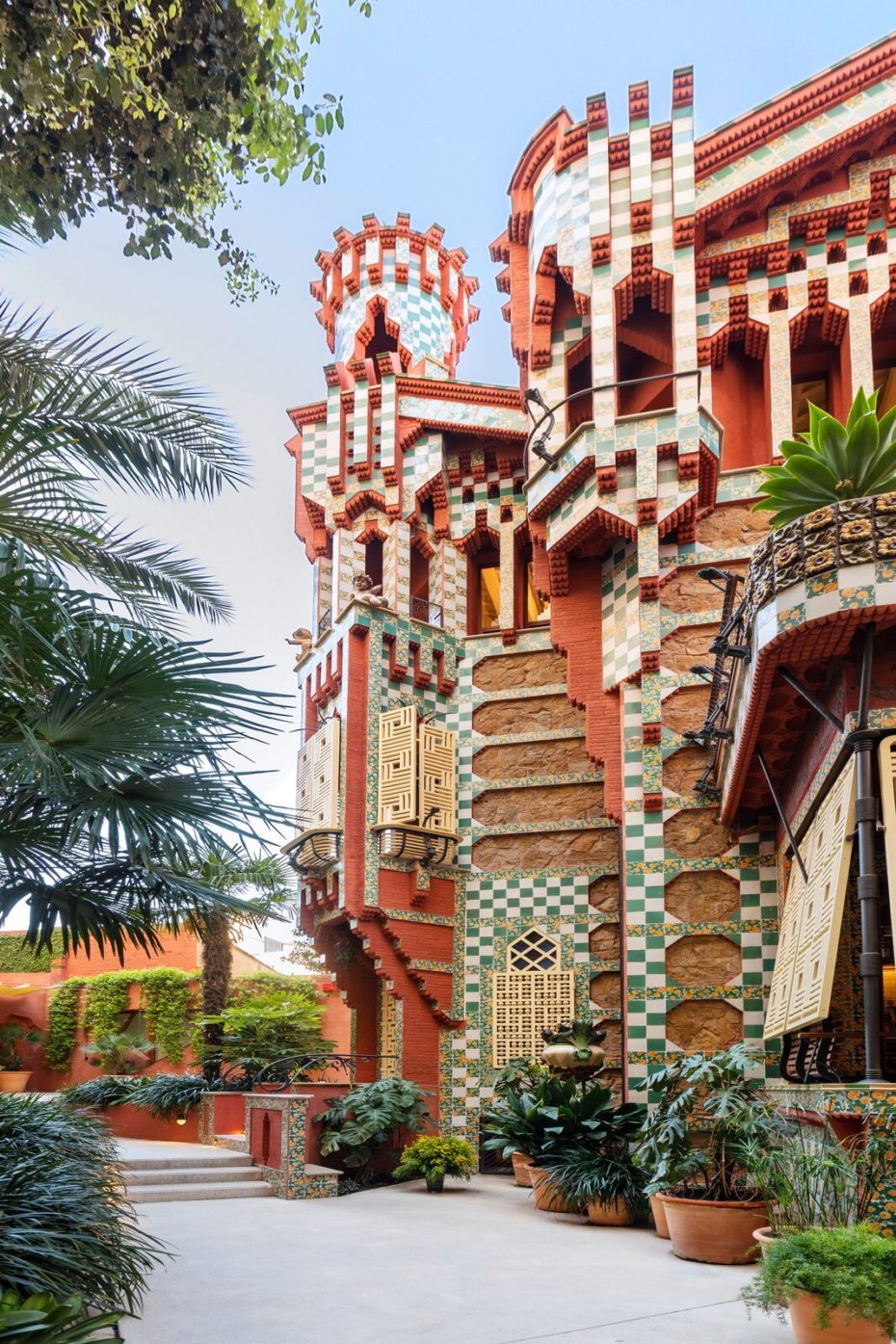
This lesser-known Barcelona landmark is the first ever house by iconic Catalan architect Antoni Gaudí, built in 1883 as a grand summer residence for the industrialist Manuel Vicens. Regarded as very special from the start, it was awarded a Best Building Award in 1927 by the Barcelona City Council, was declared a Historic Artistic Monument in 1969 and a World Heritage Site in 2005. It has recently been restored as a public museum and for one night only this autumn was offered as an Airbnb stay, an exclusive, unique treat.
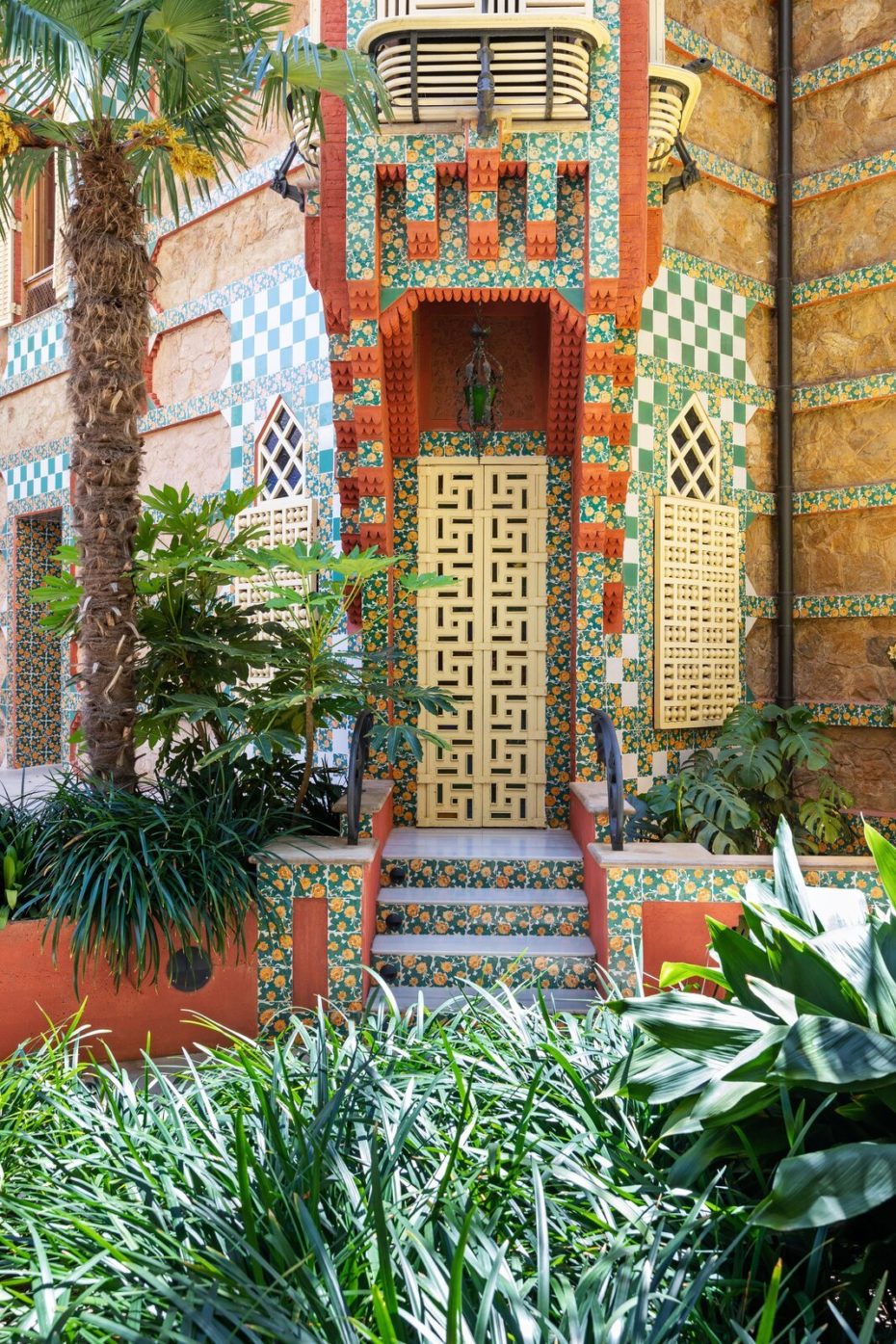
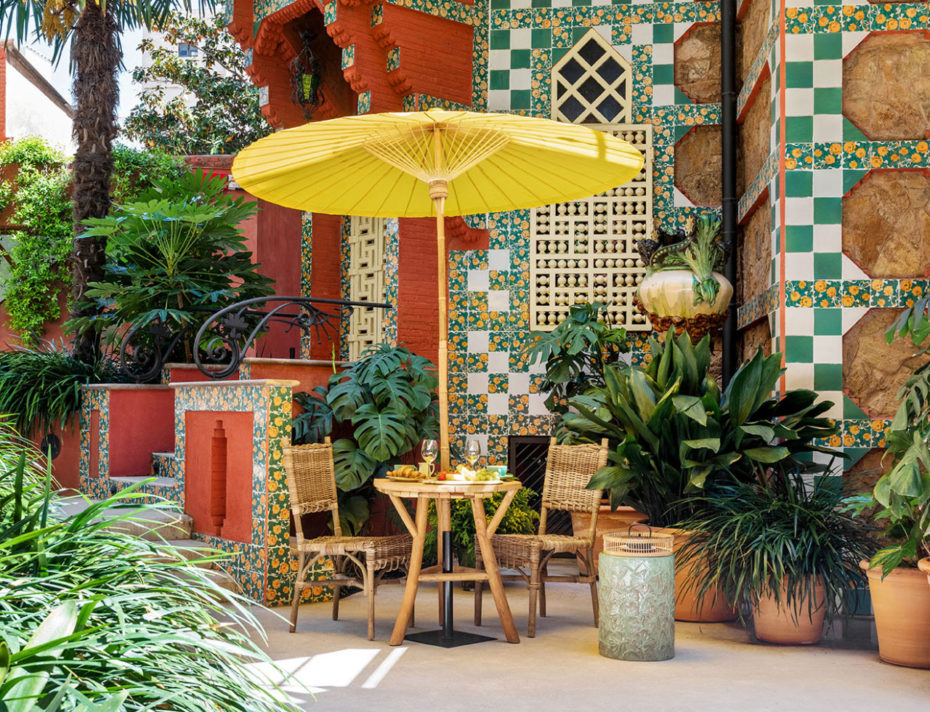
The outside of the house is a riot of brightly coloured, shiny ceramic tile stripes and bands, laid in checker-board patterns over a stone-and-brick core. The tiles alternate from plain white to deep green and orange, in floral motifs inspired by flowers Gaudí had found on the site. Sharp little glistening minarets pop up into the skyline, perhaps betraying a Moroccan influence or was Gaudí just indulging in a flight of fancy? Gaudí reportedly sat under a parasol supervising the builders, keeping a very close eye on this project that was partly a status symbol for his client, partly a home.
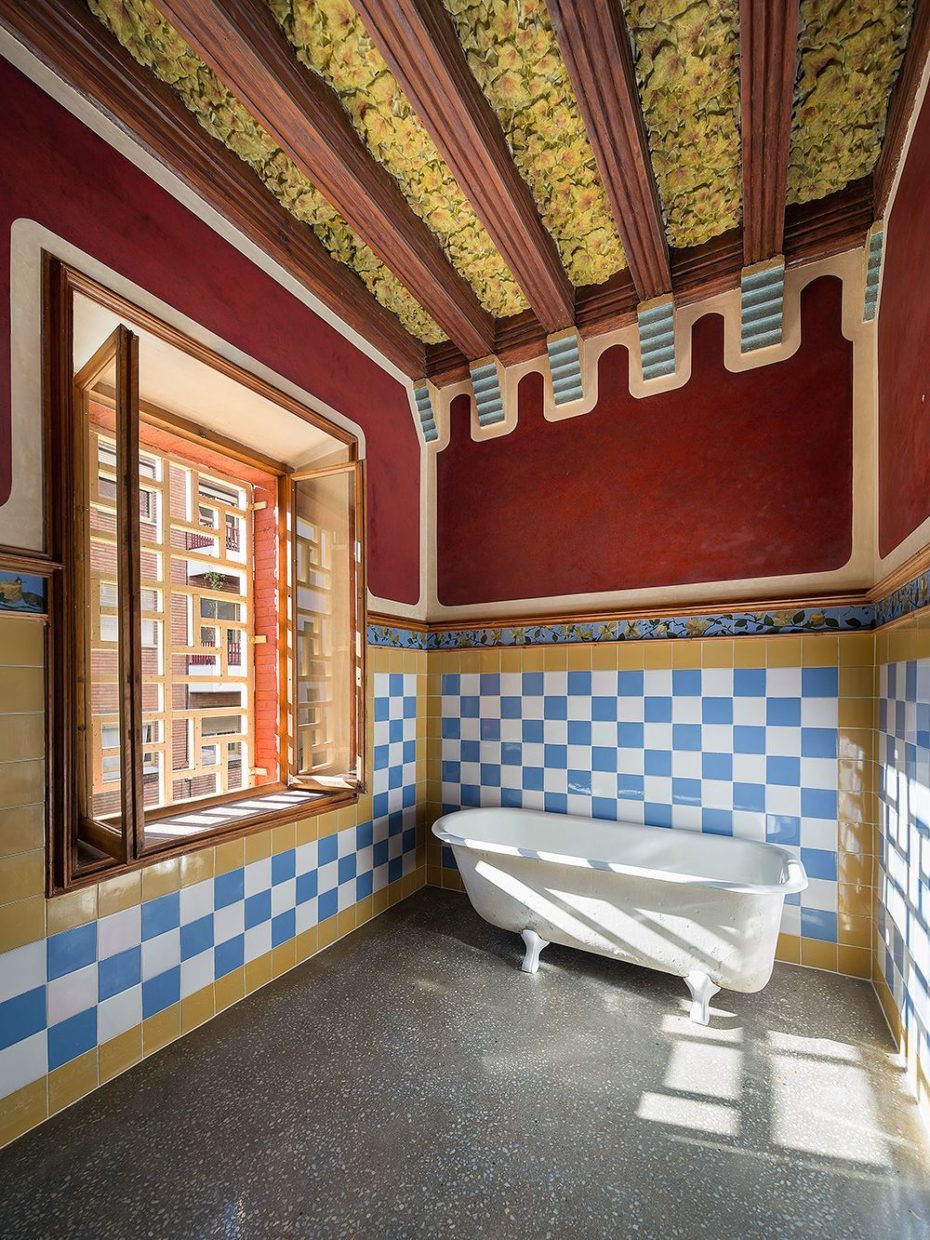
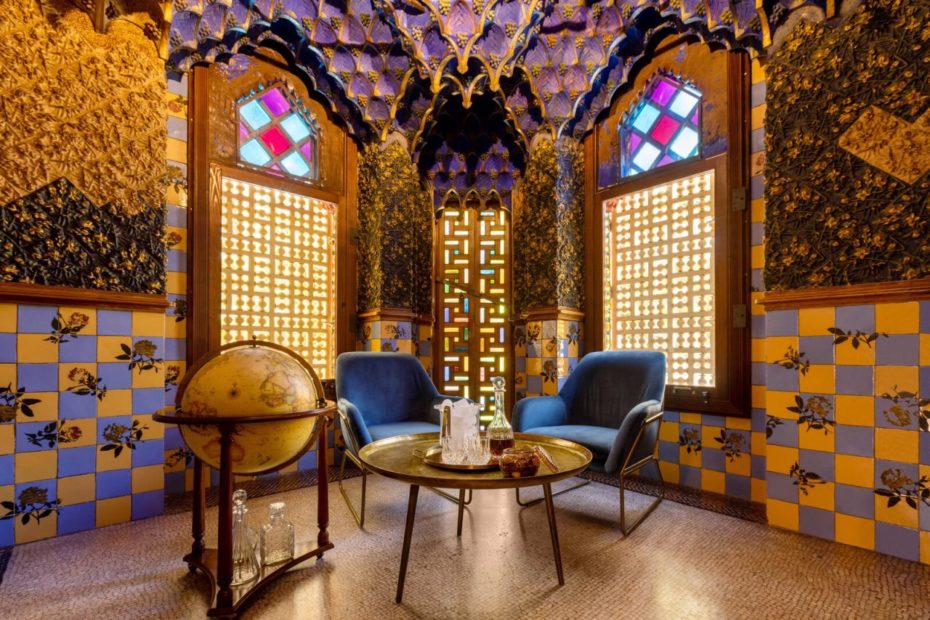
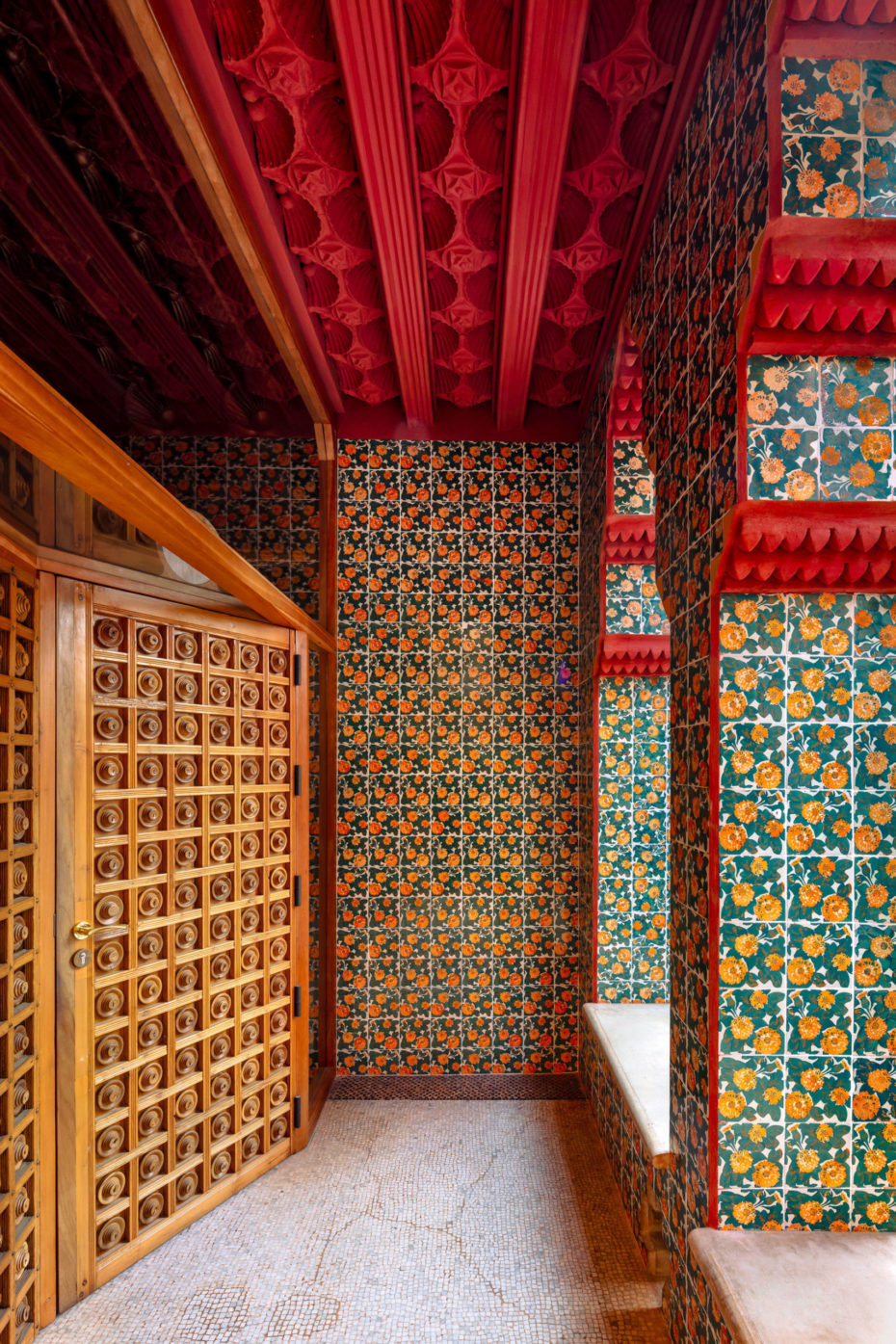
On the inside of the house tiles of all patterns and shapes cover almost every surface, marching across the floors, scaling the walls and exploding over vaulted ceilings.The bold use of ceramics to colour, add texture and organically cover buildings would become Gaudi’s trademark. In this early work the tiles are placed as they come: uncut, rectangular and regimented. The world had to wait until 1904 for the plates and tiles to be smashed and shattered to form the skin of the dragon’s hump for the roof of Gaudí’s famous Casa Batllό. Casa Vicens was just a taste of what was to come.
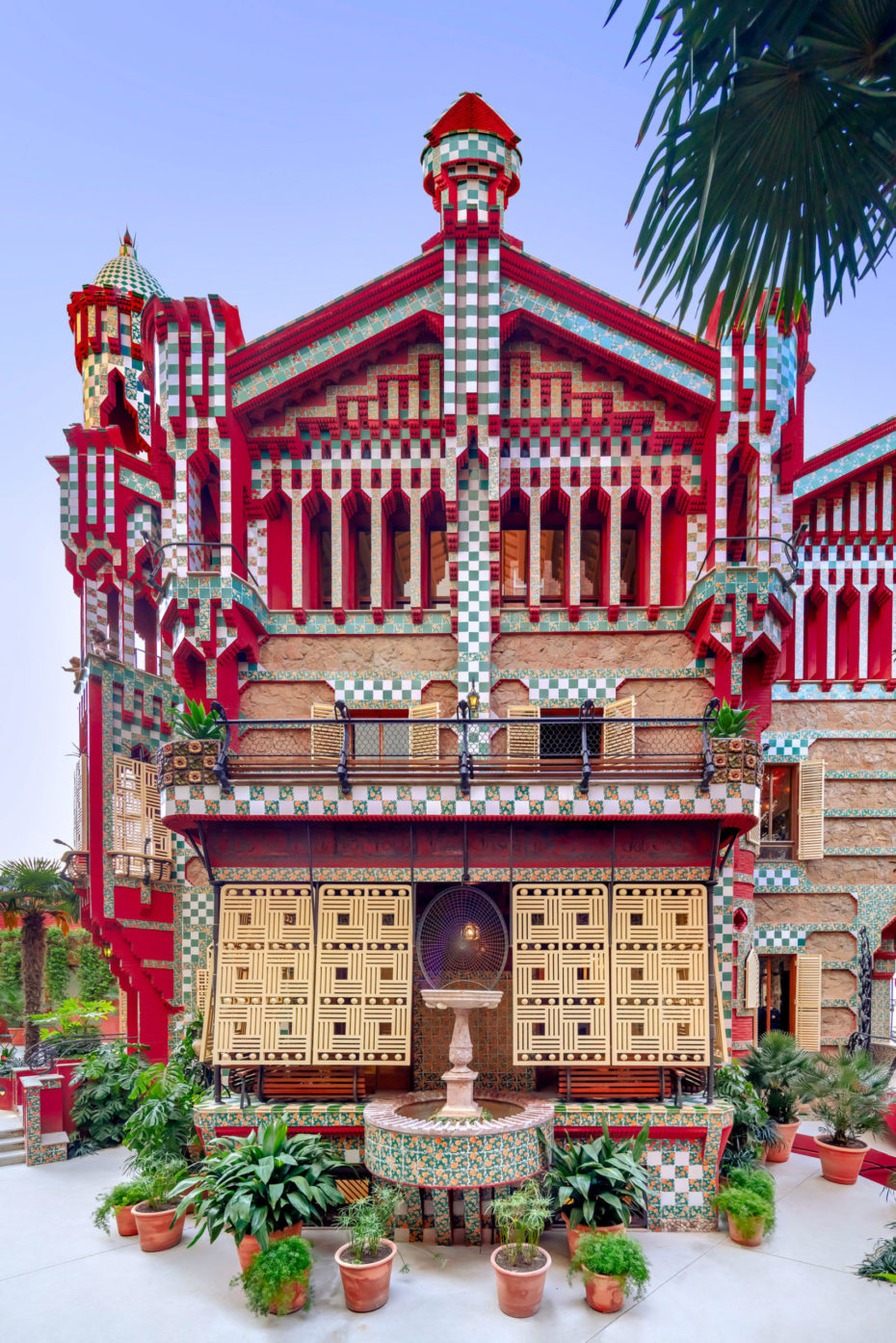
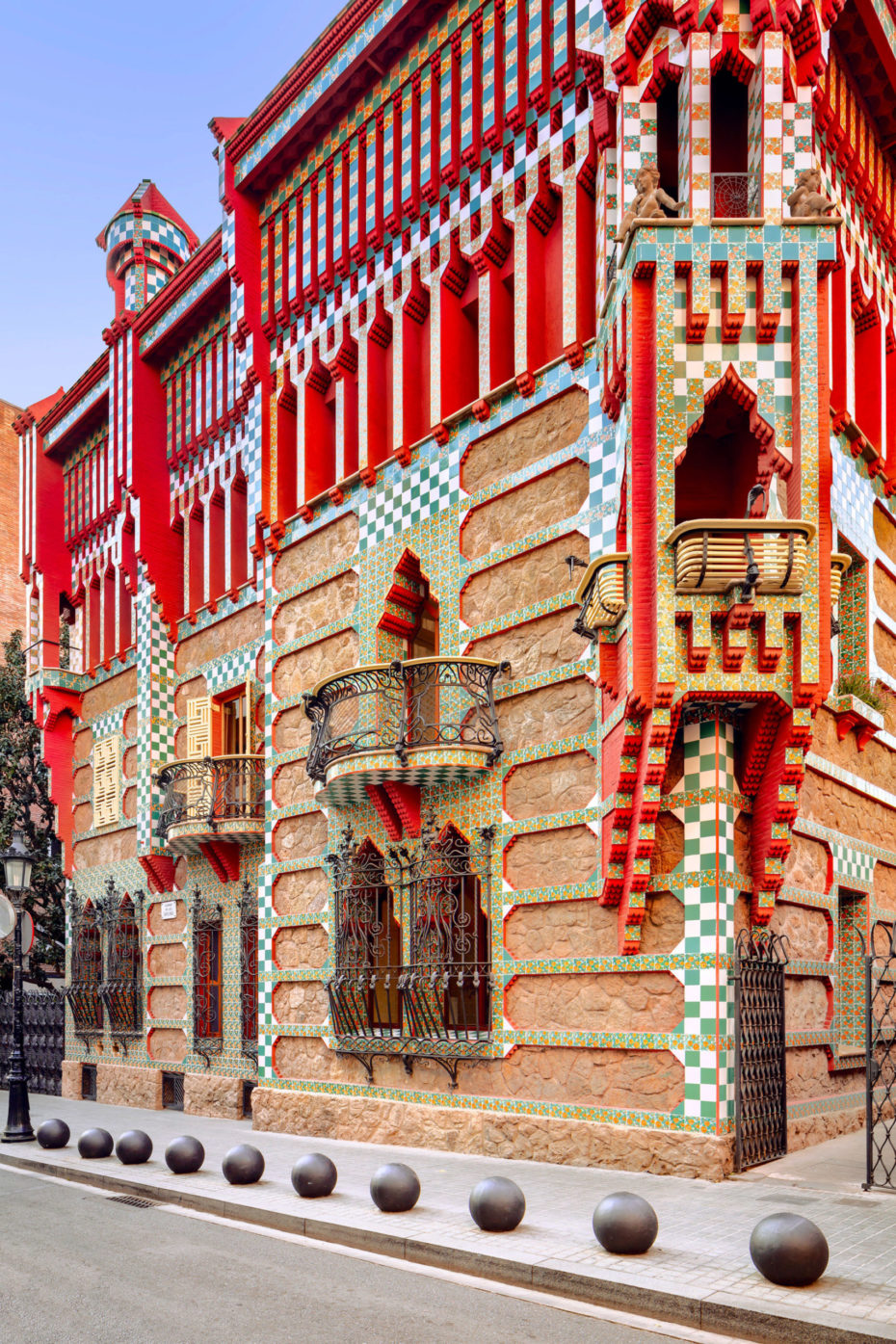
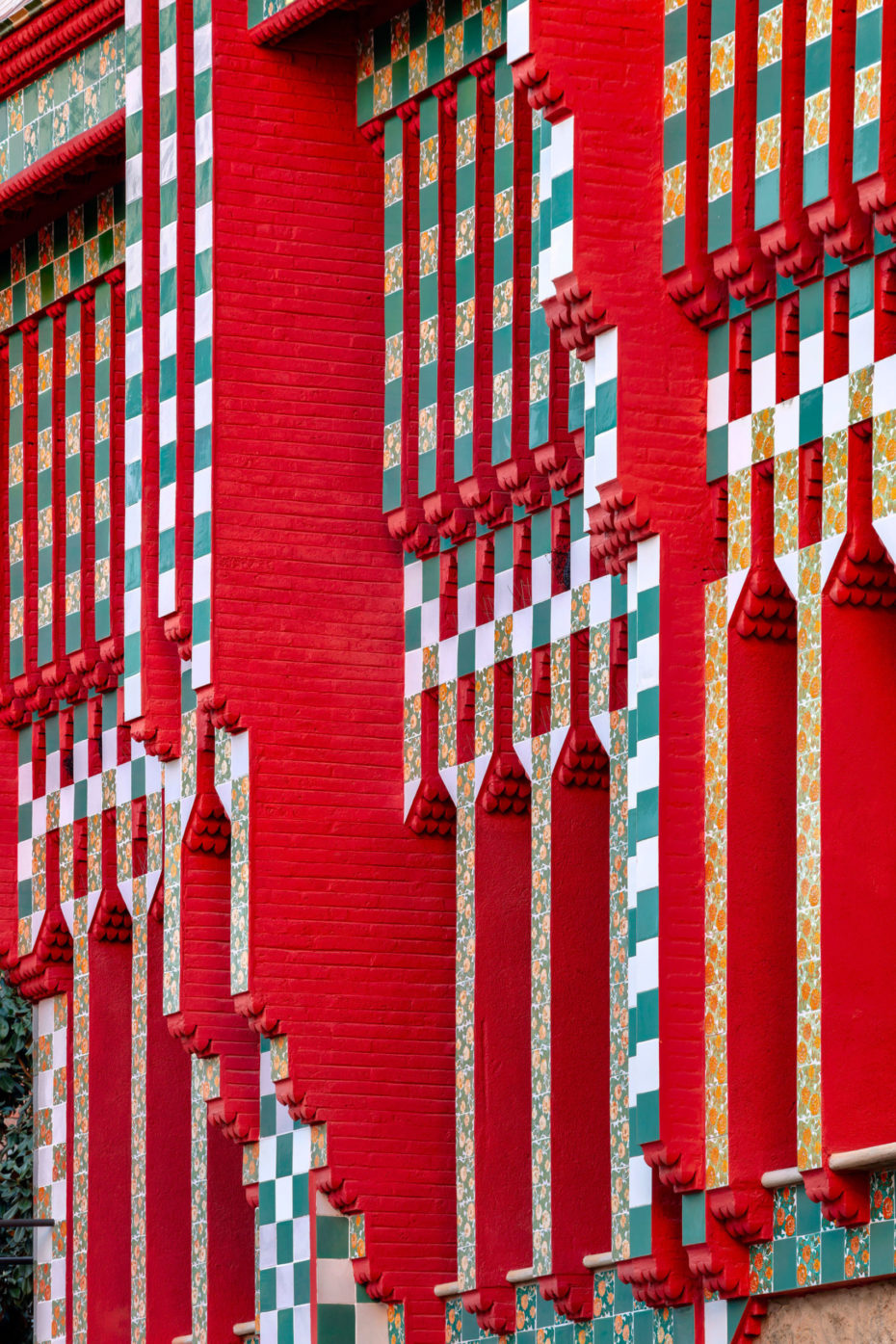
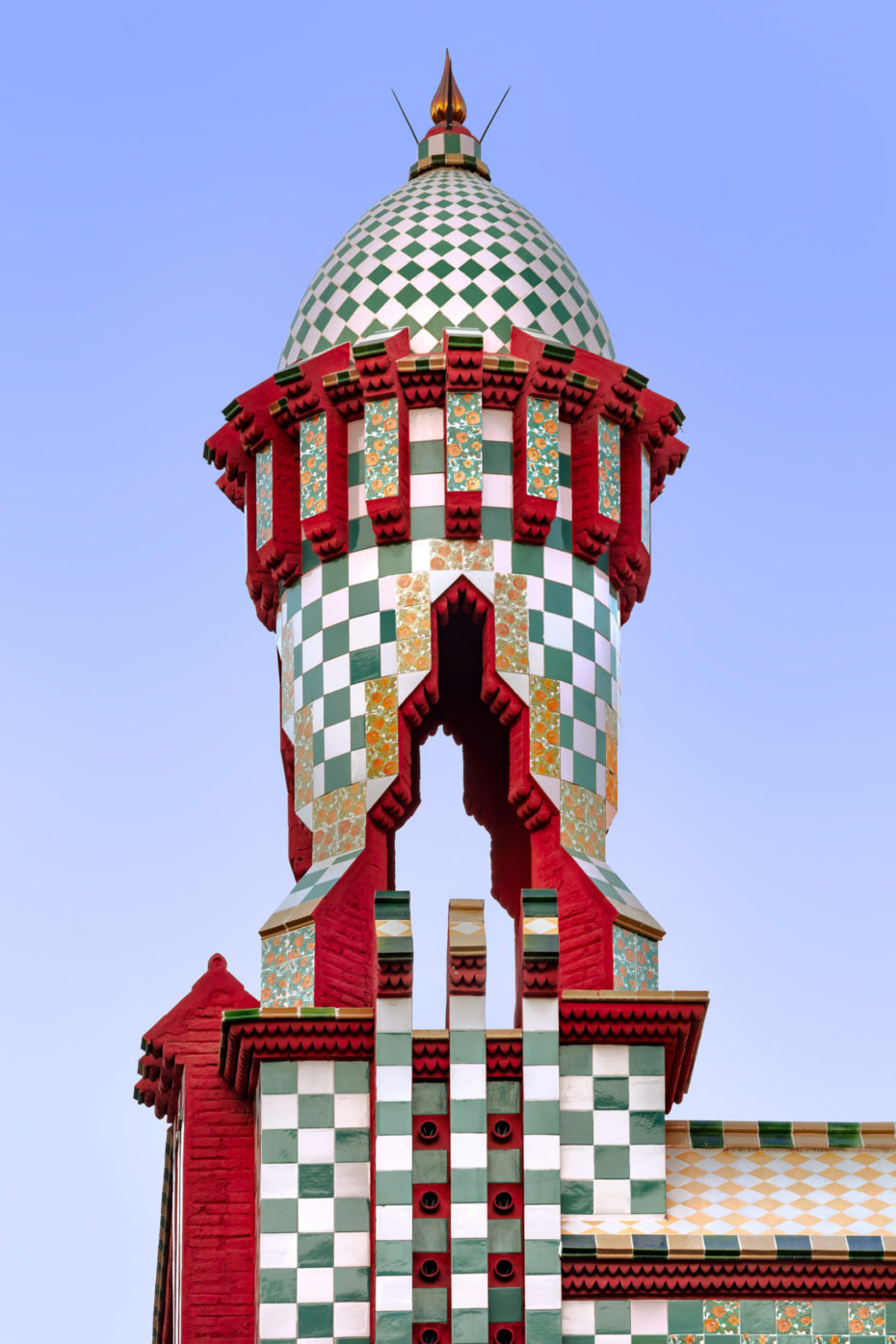
More information on visiting the Casa Vincens here.
2. Site of Reversible Destiny, Yoro Park, Japan
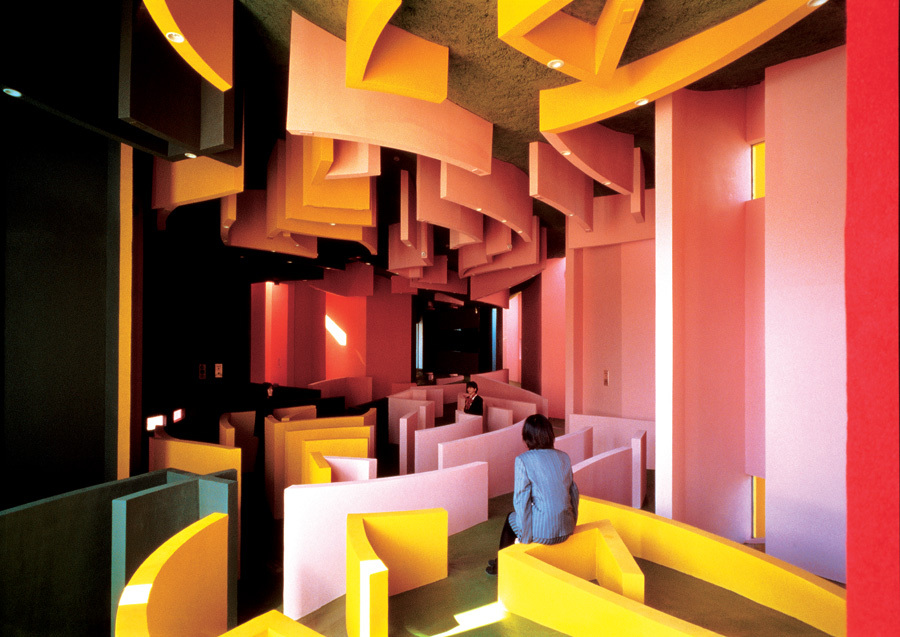
The Site of Reversible Destiny at Yoro Park Gifu, Japan is an interactive theme park opened in 1995. It is a therapeutic experience, intended to question conventionalities in the world we take for granted. The architects Shusaku Arakawa and Madeline Gins sought to create an environment where changes in how our bodies perceive and gauge the physical world would, in turn, generate changes in our consciousness. Yoro Park is an altered world where we’re invited to address a deliberately skewed, warped and twisted physical reality in order to ‘free our minds’. Our obsession with and dependence on rectilinear geometry and alignments seen in all our urban and domestic environments is challenged by leading us through a series of small building and landscape experiences.
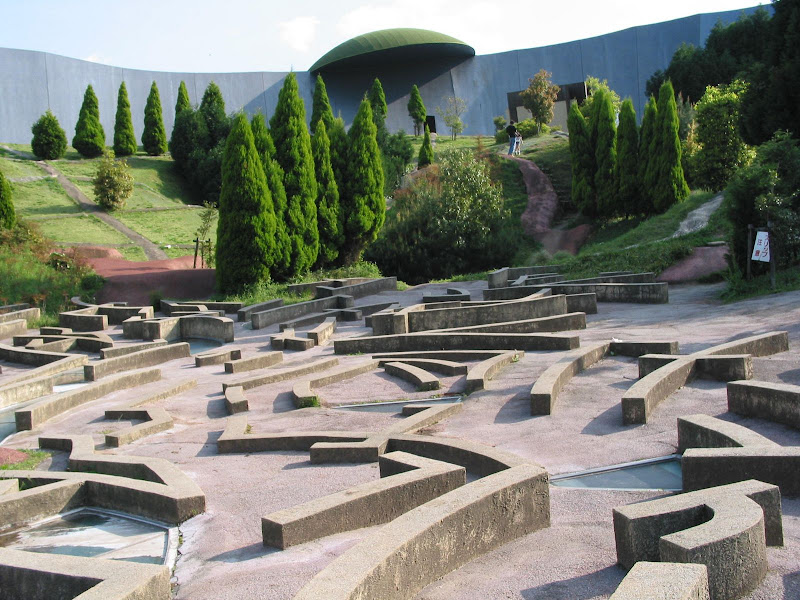
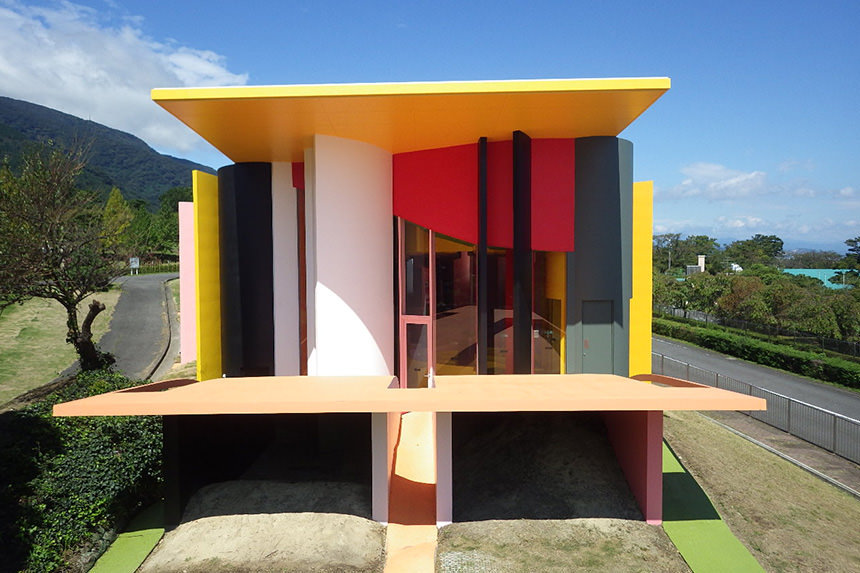
The ‘entrance’ to the Reversible Destiny experience is through the barely detectable ‘Gate of the Non-Dying’, which is a transition zone allowing free passage in all directions and begins the adventure through a multitude of structures and spaces. The ‘Office House’ is an assemblage of vibrantly painted, multi-coloured tubes with cardboard-like roofs and floors. Inside this house, a sculptured floor scape – a mirror-match of its ceiling scape – provides the first experiential challenge to orientation, are we up or down? The main pavilion, the ‘Critical Resemblance House’ is like a stack of broken jigsaw pieces, the interior experience offering an angled, sloped, light and dark sequences of orientation spaces.
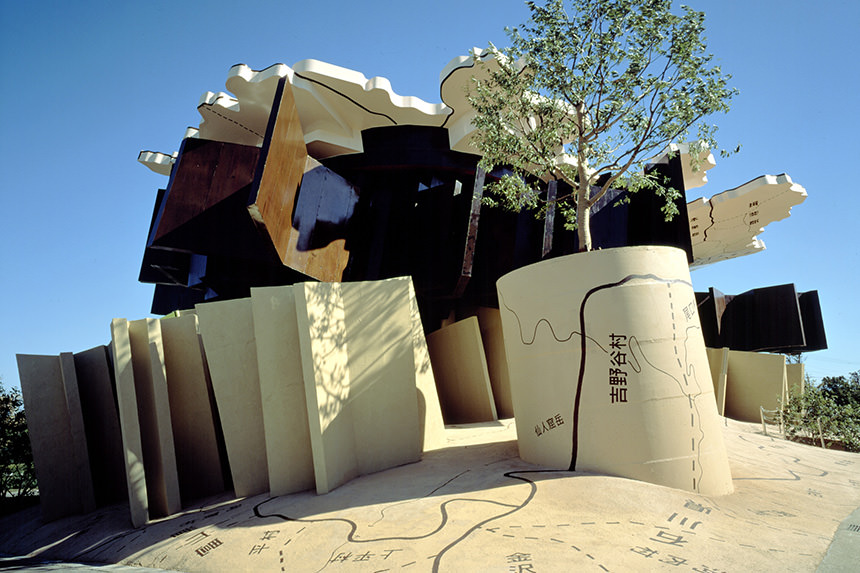
Beyond these pavilions is the outdoor ‘Elliptical Field’ where the Critical Resemblance House is recreated in nine fragmented parts. Each of the nine pieces rises skewly from an undulating and deliberately twisted ‘Alice in Wonderland’ landscape. The fragments are given odd titles such as ‘Imaging Navel’ or the ‘Mono No Aware Transformer’. Each fragment is an identical copy of a section of the Main Building, the challenge here being to decide which part is which, with the intent to kickstart your mind on a different journey of healing and ‘the avoidance of death’.
The message is that destiny – even death – can be reversed. That being said, because of the unconventional angles of travel through the park (one of the users of this park advised) best wear rubber sole shoes for safety’s sake!
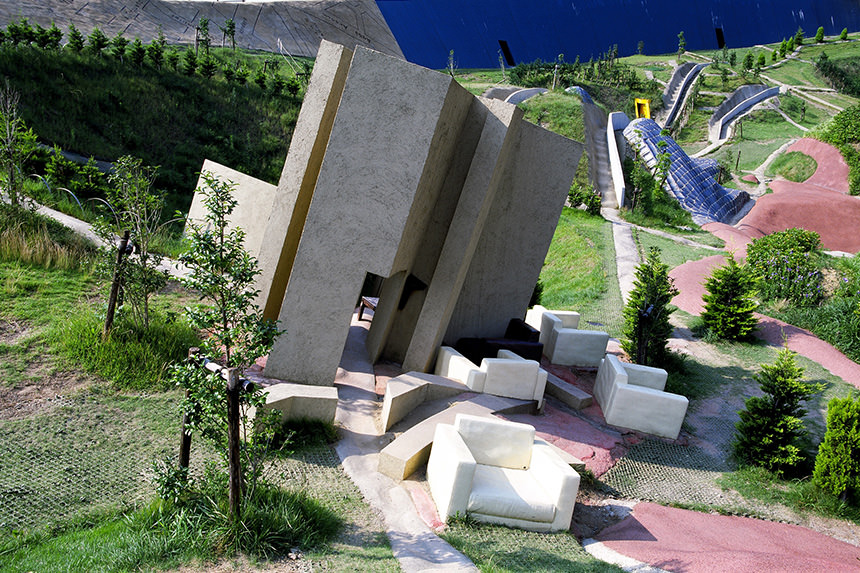
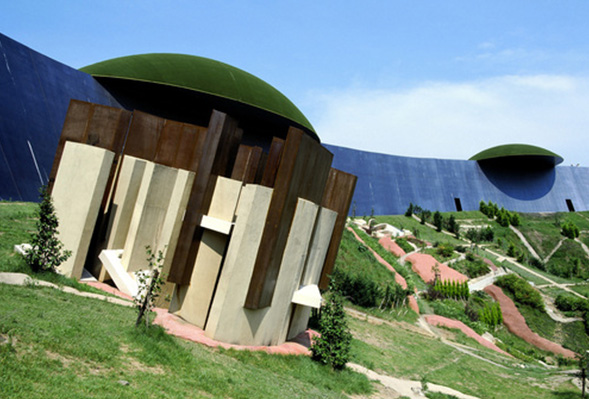
More information on visiting Yoro Park here.
3. Luna Parc, New Jersey, USA
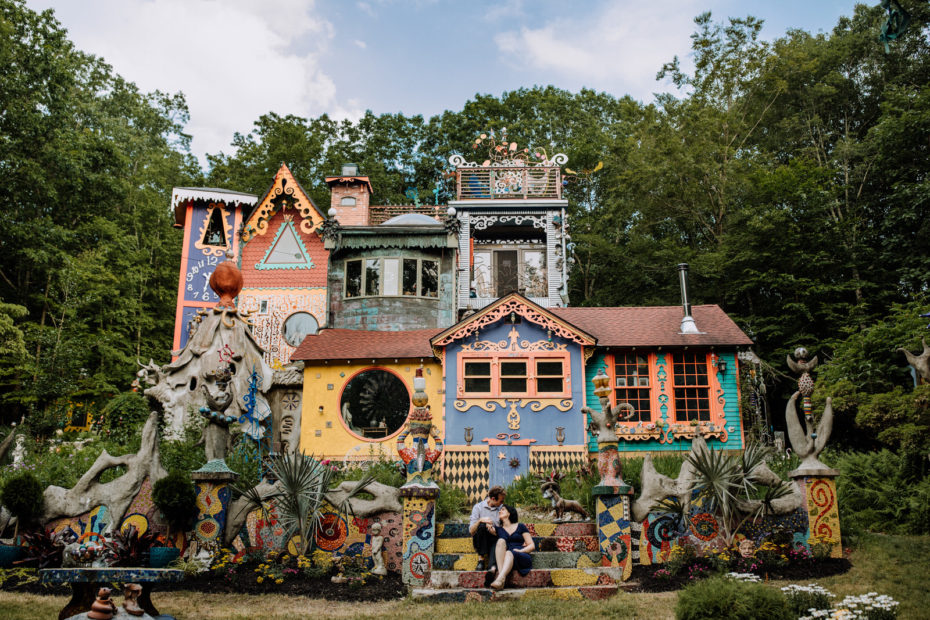
Luna Parc is Ricky Boscarino’s personal temple to art: a random yet strangely ‘together’ assemblage of vibrant and distinctive building elements built up over the past 40 years. The park, eight and half acres of New Jersey woodland, is infested with bizarre new-age sculptures in concrete and mosaic, while the house and centre-piece is a vividly coloured collection of well-considered cartoon architectural elements. Ricky Boscarino, a Sicilian by descent and prolific artist of all media – particularly all forms of sculpture, has created this glittering mosaiced palace as a piece of ‘live-in’ art. Ricky Boscarino purchased what was a very dull and non-descript house and the overgrown grounds in 1989 and has been working on his renaissance masterpiece ever since, drawing inspiration from Catalan Architect Antonio Gaudí’s work in Barcelona (especially the use of coloured broken ceramic mosaics cladding curvaceous concrete sculpted shapes).
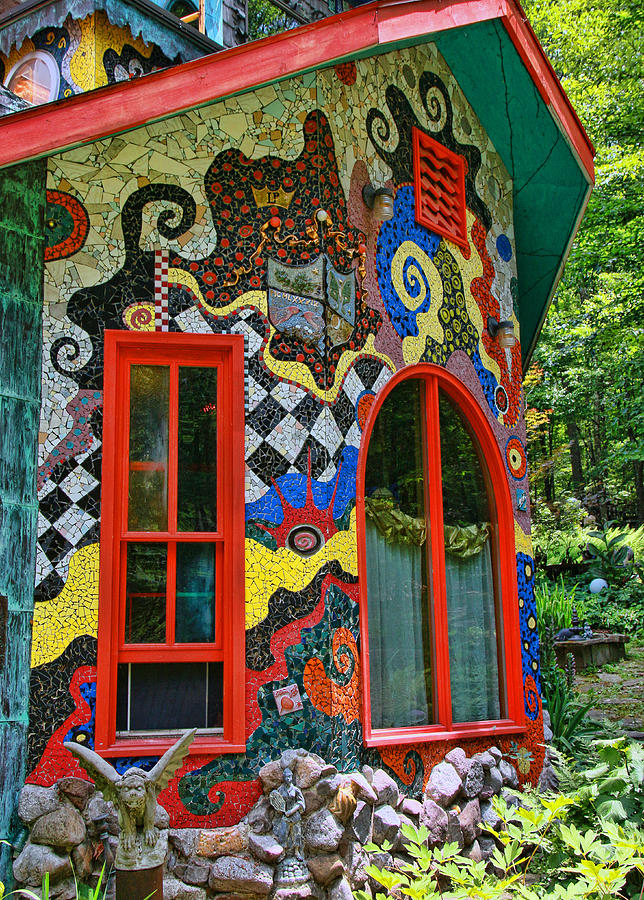
The exterior of the house is a stack of competing coloured towers, gables, bays and balconies, all as if collected and assembled from different buildings from different places far and wide. Elaborately carved fretwork chalet window surrounds sit beside lacy cast ironwork, a vast Chinese round windows looks across the garden, a cartoon clocktower breaks the skyline and a wilted pineapple-like concrete entrance dome are just a few items on this very fruity architectural menu. The skyline is topped with exotic weathervanes, clocktowers, figurative sculpture and domes. The walls are awash with delicate illustrations of mermaids, fish, bats, ghouls, stars and the exotic in general. The overall composition, although apparently random, visually holds together with a common intensity of decoration – not unlike a group of brightly dressed kids standing closely shoulder to shoulder, all beaming smiles to the front.
Within the house, no surface is left untouched. Every wall is a canvas and well-composed artwork. Within each room, the floor, ceiling and the 4 walls offer six surfaces as a vibrant and sparkling mosaic composition. Stained glass windows abound tell stories of life from birth to death, mosaic sculpture grows from the mosaic floors and walls, and a curated selection of antique artefacts adorn special positions around the walls.
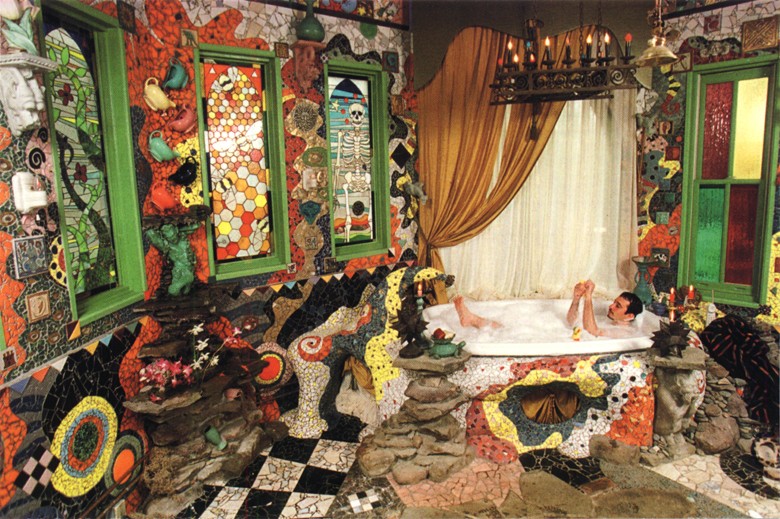
The name Luna Parc is taken from a similarly named amusement park outside Rome, close to where Ricky Boscarino spend an overseas year from the Rhode Island School of Design. Ricky’s family – proudly Italian, were makers and creators, his parents furniture builders while his sisters are artists too. Luna Parc is not only Ricky Boscarino’s home, it serves as his studio too and several times a year he invites the public to visit. He also offers workshops and rents it as a unique wedding venue.
Luna Parc is more than just a home, it is Ricky Boscarino’s vehicle to encourage the arts in us all. Office, shop, jewellery studio, pottery workshop, educational centre, museum and spiritual garden, Ricky Boscarino uses the garden and building spaces to demonstrate to adults and children alike how art can be ‘lived in’, a stimulation, an enrichment and essential part of life. He is not aiming to convert all to being accomplished artists, but wants to encourage an individualism and creativity in us all.
More about visiting Luna Park here.
4. The Villa Palagonia, Baghria, Italy
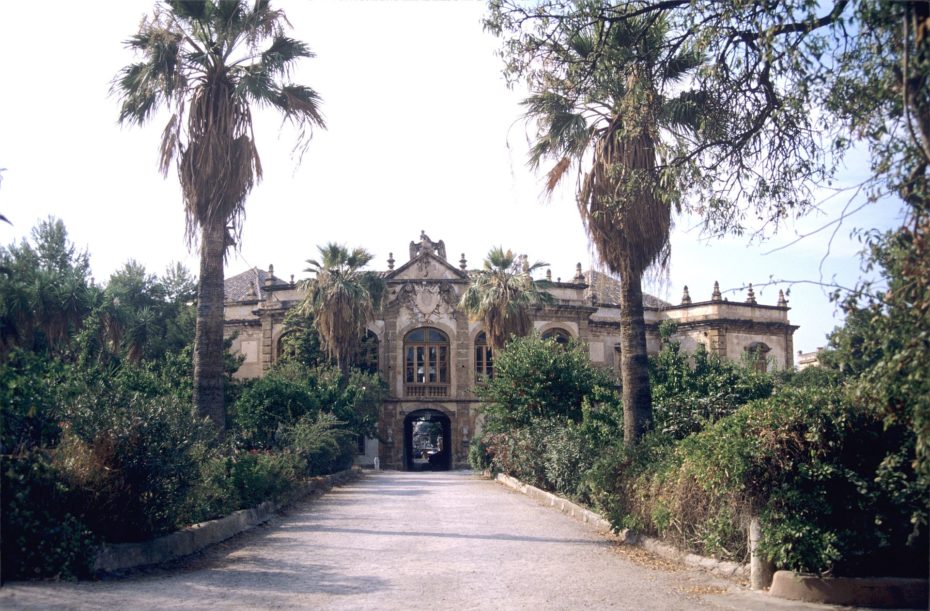
The crumbling Villa Palagonia, sometimes open to the public, buried in the town of Baghria, close to Palermo, Sicily, is an overflowing baroque basket of the richest architectural and sculptural fruits you could imagine. This palace is an undulating and heaving mass of outlandish figurative sculpture looking down on the human show below, like some belligerent ancient Roman crowd at the games.
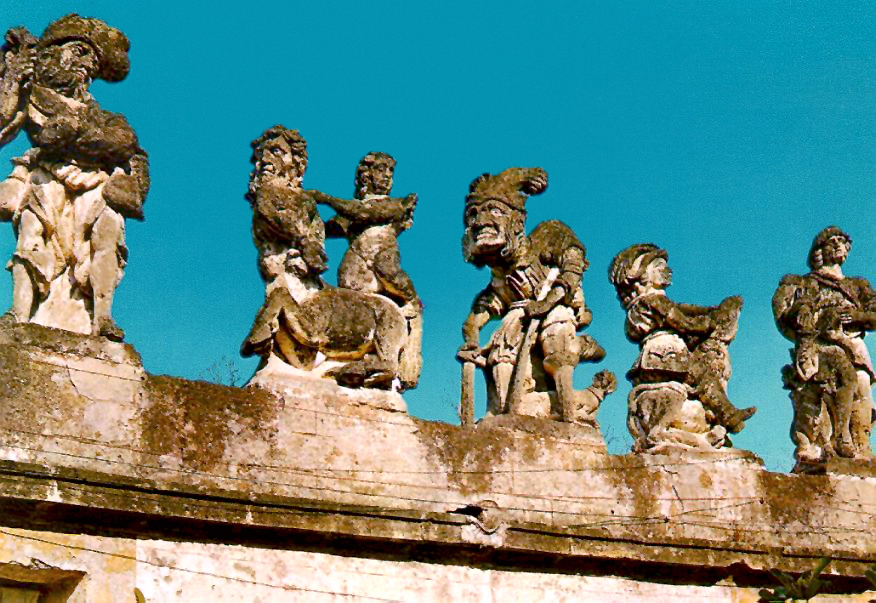
This palace, a restless assemblage of undulating Italian baroque towers and pavilions was built for the 5th Prince of Palagonia. It was his successor, the 7th Prince of Palagonia who populated the walls and gardens with over 600 very cheeky and grotesque statues.
In 1787, visiting poet Wolfgang von Goethe described the bizarre exterior;
‘To convey all the elements of the madness of the Prince of Palagonia, here’s the list. Men: beggars of the two sexes, Spaniards and Spaniards, Moors, Turks, Humpbacks, Deformed of all kinds, Dwarves, Musicians, Pulcinella, Soldiers dressed in the old fashion, Gods and Goddesses, Ancient French costumes, Soldiers with pouches and men, beings mythological with comic additions (…) Beasts: isolated parts of the same, horses with human hands, human bodies with equine heads, deformed monkeys, numerous dragons and snakes, extremely varied legs and figures of all kinds, splits and exchanges of heads . Vases: all the varieties of monsters and cartocci that end in bellies of vases and pedestals. Imagine these figures galore, meaningless and without reason, put together without choice or discernment, imagine these clogs and pedestals and deformities aligned as far as the eye can see: and you will experience the painful feeling that oppresses those who find themselves passing under the rods from this madness’
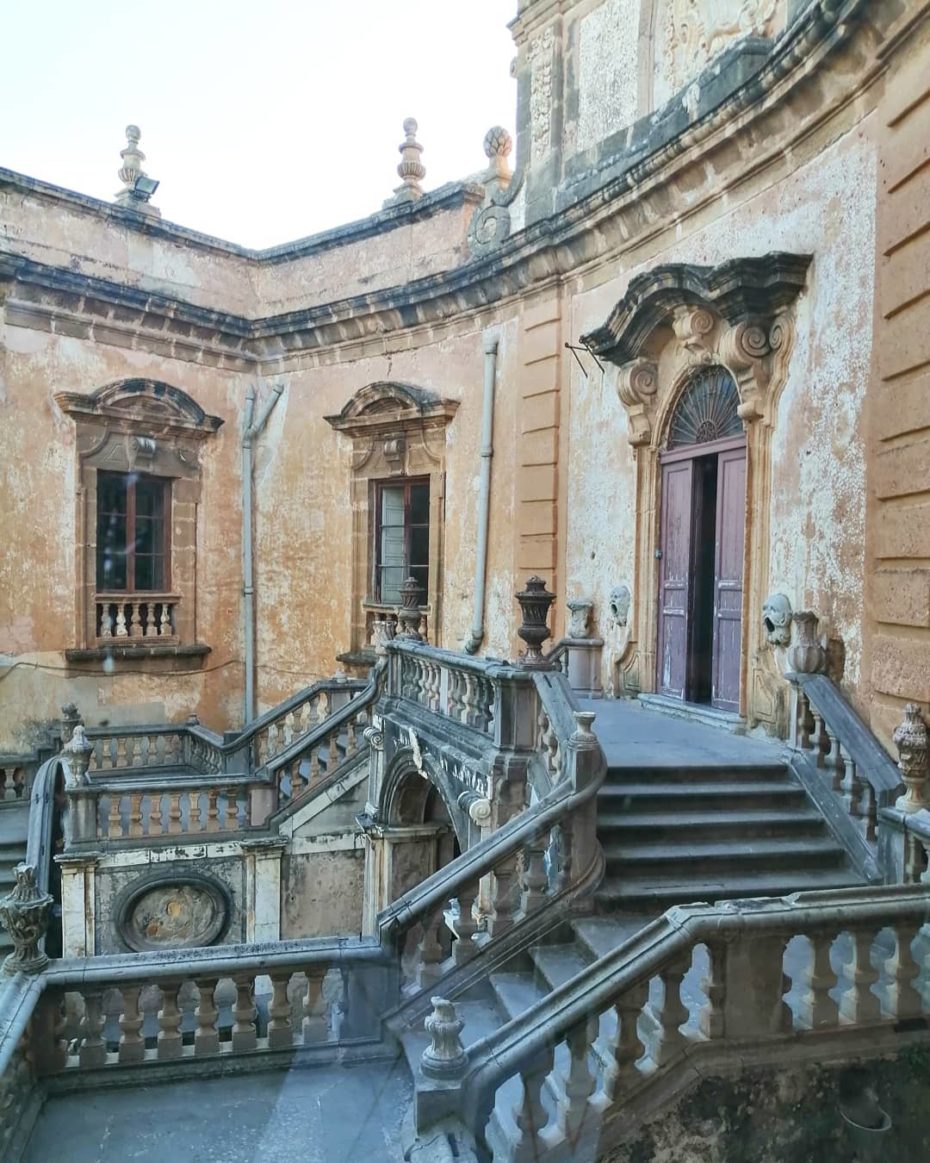
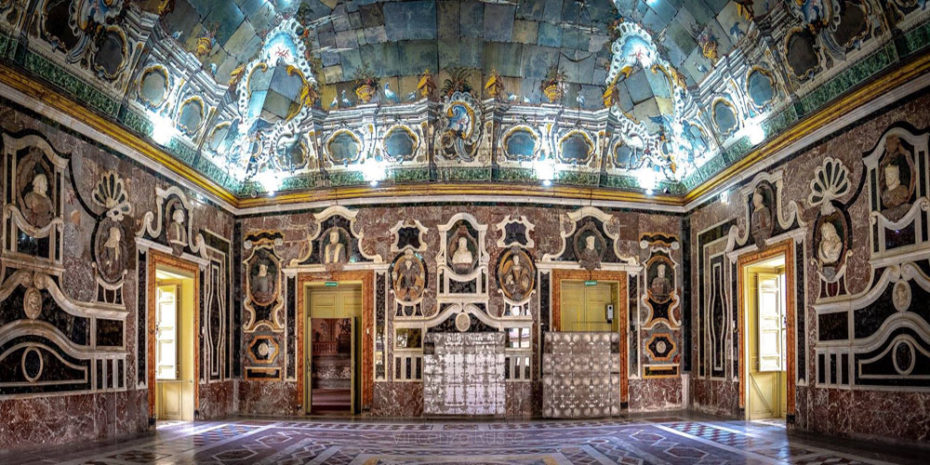
Goethe goes on to describe an aspect of the interior,
“The feet of the chairs are unequally sawn, so that no one can take a seat and, in front of the entrance, the caretaker of the building invites visitors not to trust solid chairs because under the velvet cushions they hide thorns.”
Within, the small windows and vaulted ceilings keep the hot and bright summer at bay. Every inch of the interior wall surfaces is encrusted with classical motifs, pediments, entablatures, niches, pilasters, busts and domes. These are restless and confusing rooms! This seemingly relentless and endless display of ancient Roman icons – both inside and out – shout, ‘there’s no place for you here, you’re not invited to this party!’- or so it seems.
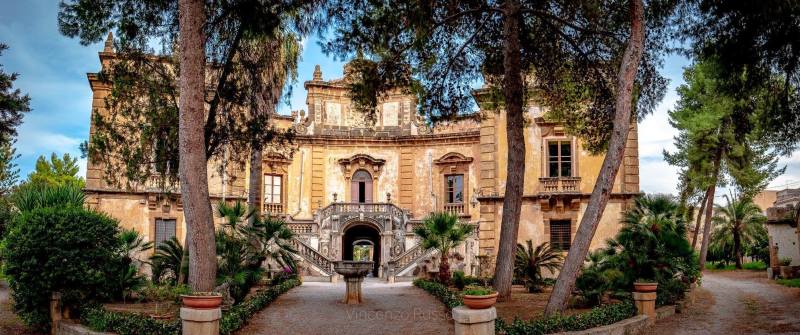
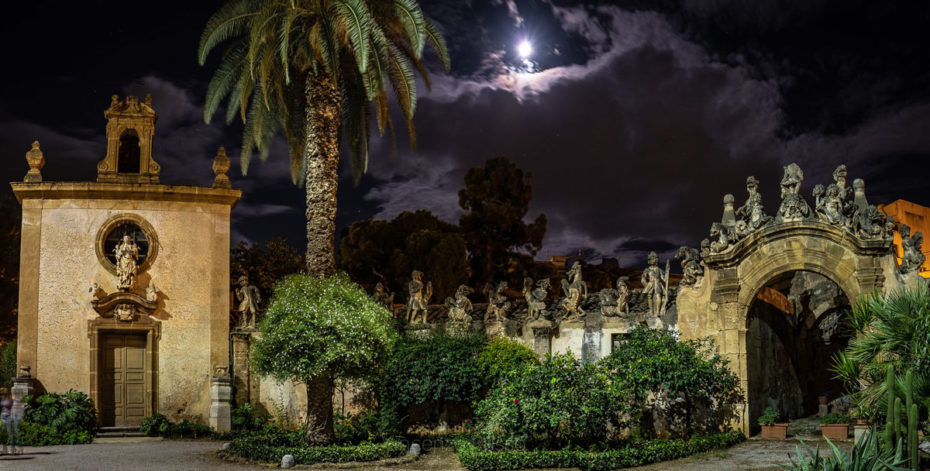
More information on visiting the villa here.
5. The House of Dreams, London
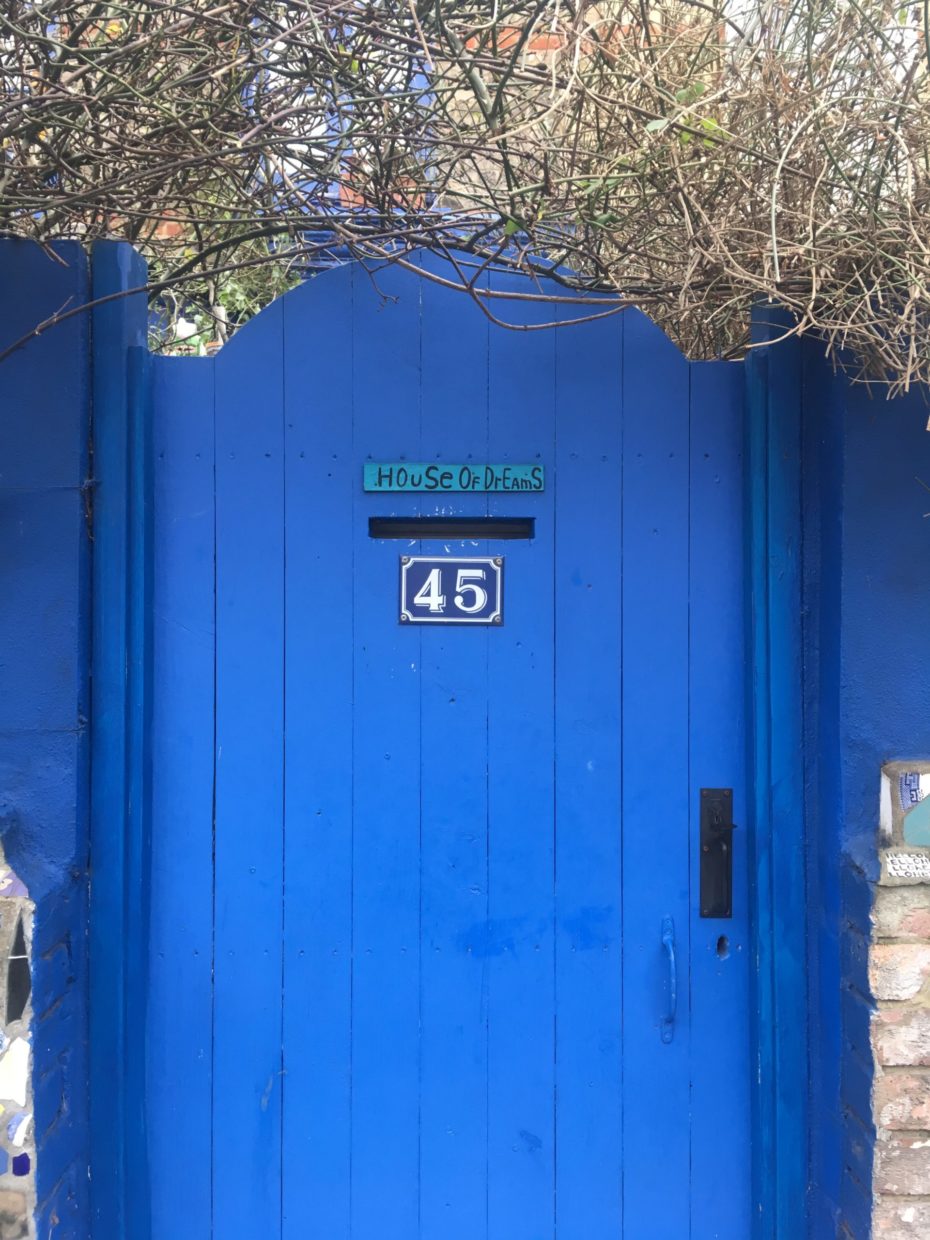
Steven Wright, a textile designer, the owner of The House of Dreams, allegedly wanted to create ‘something decorative’. His canvas was a very ordinary semi-detached house in Melbourne Street in the quiet London Borough of Dulwich.
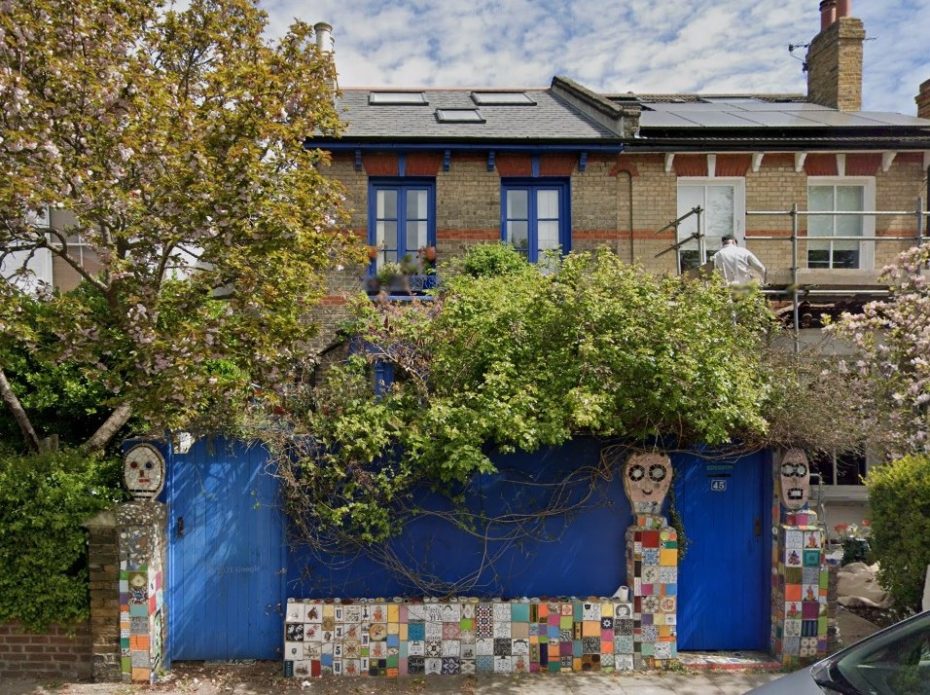
Hidden behind a tall old garden wall, topped by a mass of tangled vegetation, the only indication of something happening here are a few old tiles edging the wall base. No grand entrance – only an unassuming cobalt blue wooden door with the smallest of signs, which offers no hint of the marvels that await inside.
This is both a mausoleum and museum. Dedicated to his parents and deceased partner, Steven Wright has recast his modest London house, room by room, into a mosaic-clad Byzantine shrine filled with a congregation of vibrantly coloured, multi sized bashed and bruised dismembered plastic dolls and trashy religious icons.
The Virgin Mary, the devil himself, Betty Boo and Crusty the Clown hold court here. Seas of bottle tops wash across doors and dolls are strung upside down, a mannequin is crusted in old bottle tops and badges, loose plastic eyeballs stare out, rivers of spiritual text run along walls and floors, curtains of plastic bottles drape across doorways, plastic cups, plastic anything … all stacked, piled and pinned to every available surface. The garden is infested and dripping with plastic rejects: Plastic birds sit perched in the trees, and dozens of lost plastic dolls’ hands are littered among the plant pots. That being said, this is a working museum, offering tours and in the museum shop there are hand-crafted pieces on sale. There are dolls heads on cleaning fluid bottle bases, alien-like stuffed textile animals and recycled oil cans, twisted and augmented into industrial chimera-like beasts. There is joy in the junk, this is an endearing shrine to trash. The upscaling of junk to icon status sends the message there’s no such thing as ‘away’ when we throw stuff away!
Book your visit to the House of Dreams.
6. Bruno Weber Park, Zurich, Switzerland
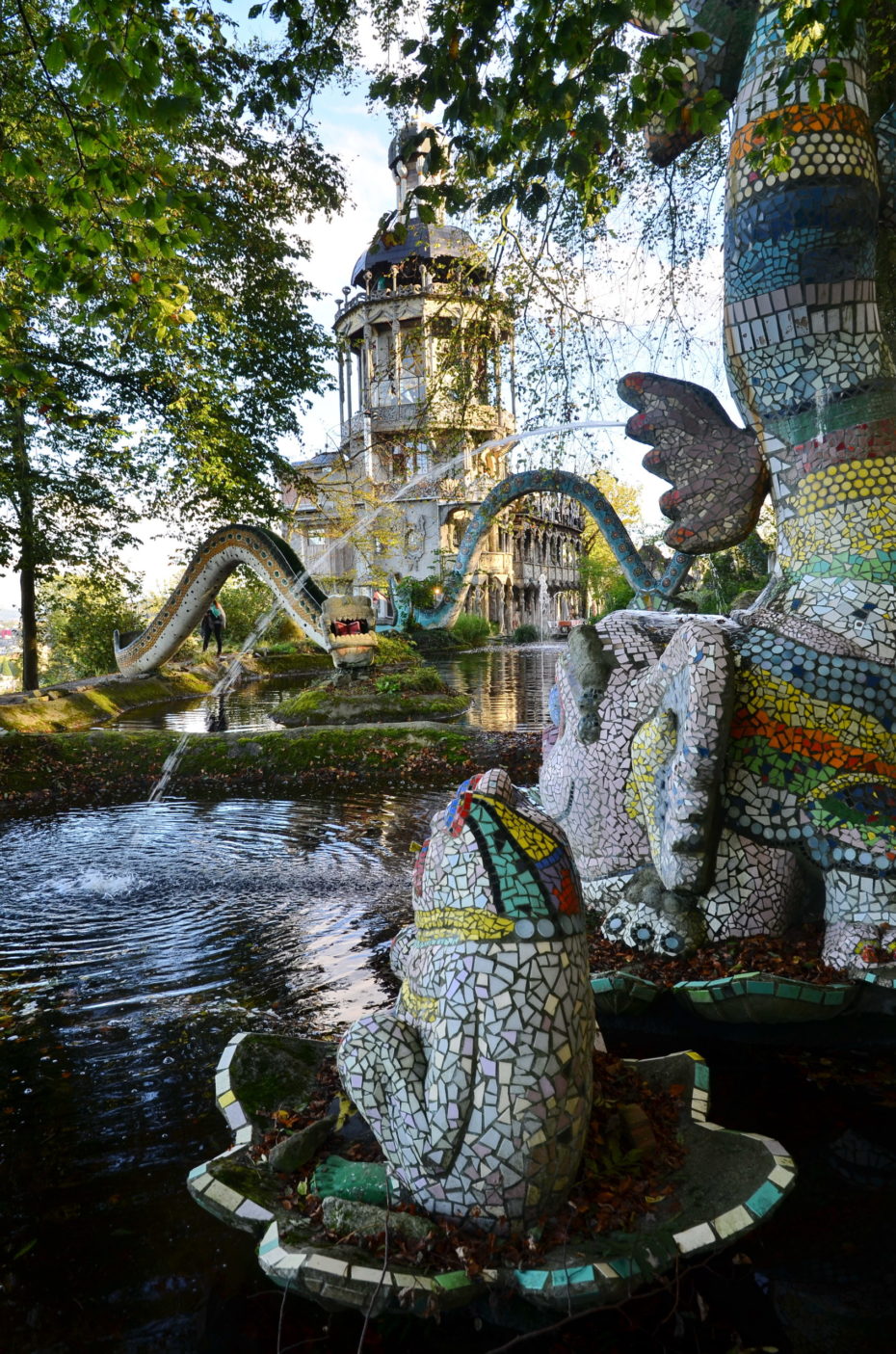
Bruno Weber was a Swiss artist, architect, sculptor, inventor and showman. He inherited a 20,000 sqm country estate at Dietikon, Zurich from his parents in 1962. Bruce then, for his own amusement, set about transforming his estate into a vast sculpture garden to contain his wonderful creations of gigantic and colourful mythical beasts. He relished working with concrete which gave him the ability to fashion enormous organic shapes to which he would add ceramic and glass to give colour and vibrance. He first created the two iconic giant concrete dragons (dragons became his trademark pieces) complete with ceramic scales and glass eyes in 1966.These were soon followed by giant snakes, water horses, snails and unicorns, all encrusted with colourful, scintillating ceramic skins made from broken ceramics, reminiscent of Antonio Gaudi’s works in Barcelona.


The heart of the estate is the sharp, spiky house of now recognisable architectural style. Sharp spears, arrow points and pinnacles are sprouting and protruding from every roof angle. The parapets are lined with the tortured faces of screaming giants and the verandas are supported by surreal, winged columns. Dragons defend the entrance while above is a giant glass look-out tower, reminiscent of an oversized lighthouse lantern, crowning the composition. Every inch of the outer walls is decorated with images of exotic creatures and mythical beasts. Inside the house, the rooms flow into each other, the liquid concrete construction appears to have spilled through doorways, across the floors and up the walls.
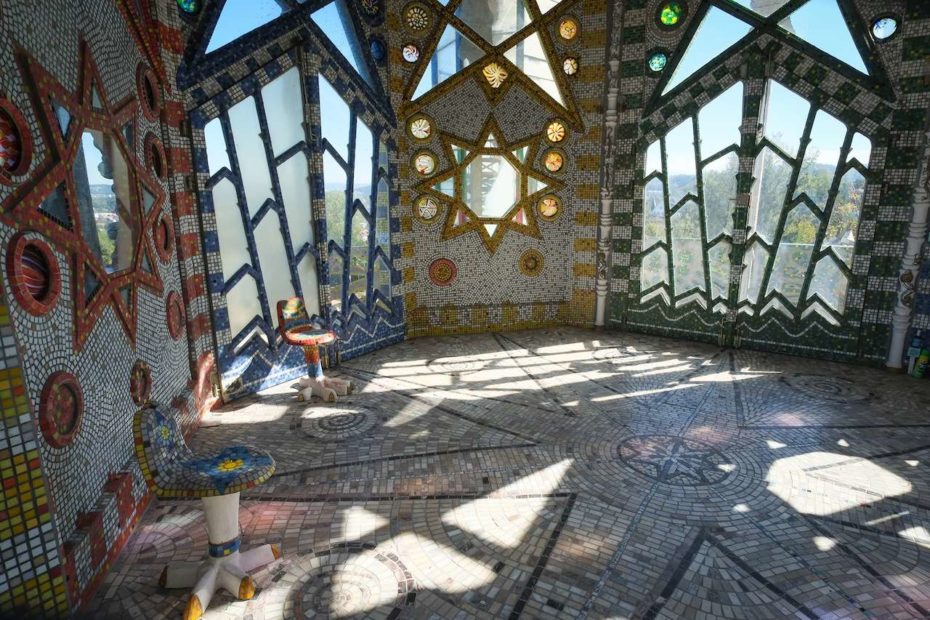
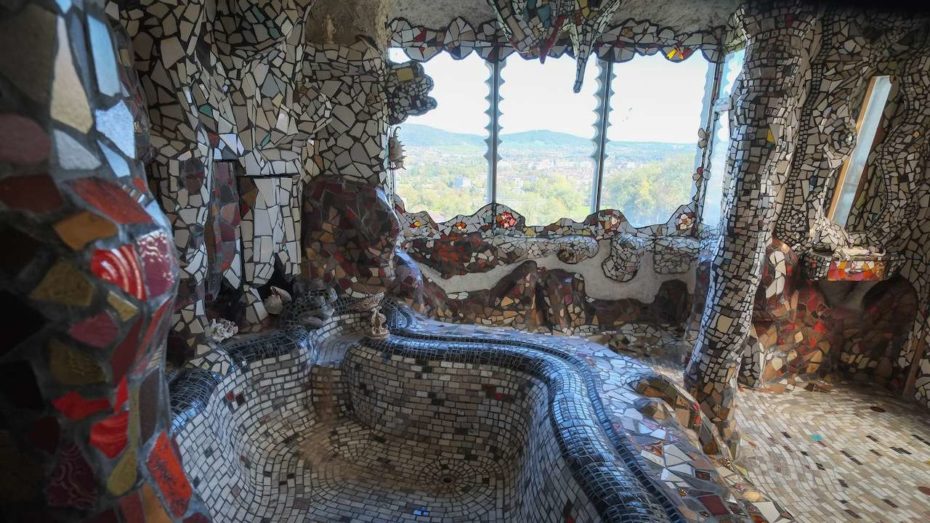
These fluid organic surfaces are covered with vibrantly coloured pieces of broken ceramics, no surface is left undecorated: basins, mirrors, stair handrails have all been given a broken plate ceramic coating. Bruno Weber had anticipated that the public might share his fantasy world but even with up to 20,000 visitors in a year in 2012 the park couldn’t make it work commercially. To this day the family continues to petition the authorities for aid and recognition for this grand folly.
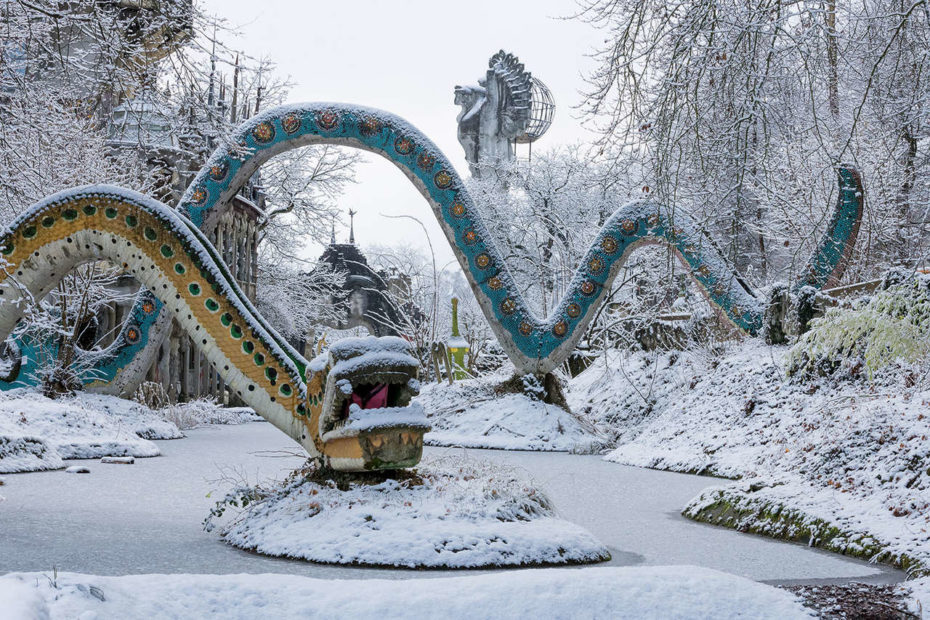
More information about visiting Weber Park.
7. Cano’s Castle, Colorado, USA
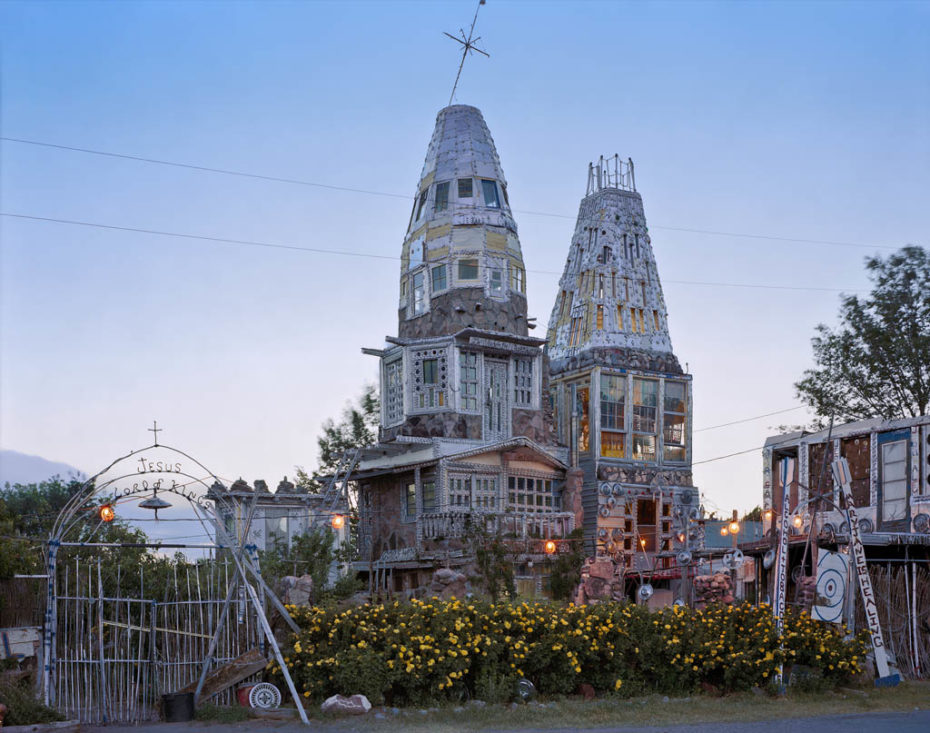
The shiny metallic stacks called Cano’s Castle stand in the dreary and deprived suburb of Antonito, Colorado, USA. It is a private house which is not open to the public. This so-called castle was built by Dominic “Cano” Espinoza, born 1948, a native American and Vietnam War veteran to celebrate his survival of the conflict, which he attributed to God. Cano (‘Cano’ is Native American for ‘reborn’) claims it was actually built by God himself, that it is the castle of Jesus and indeed it is only Jesus who lives there. Cano lives in a mobile home on the far side of the road.
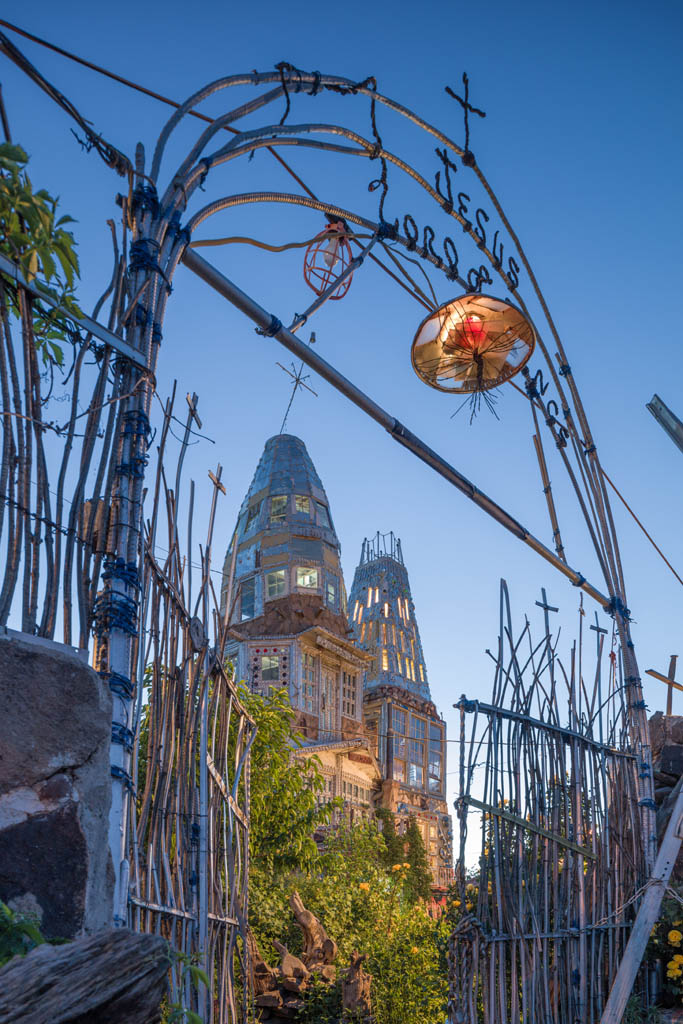
Like the great cathedral builds of old, this is an endless project which started almost 35 years ago. Reusing the foundations of the regular house, garage and shed on the plot, each of these structures is now enveloped by an explosion of glistening raw, recycled metal scraps: cans, grills, hub caps, bars, tubes, sheets, foils, bolts, glass – in fact anything old that can be reused and that sparkles and twinkles in the divine rays of the sun.
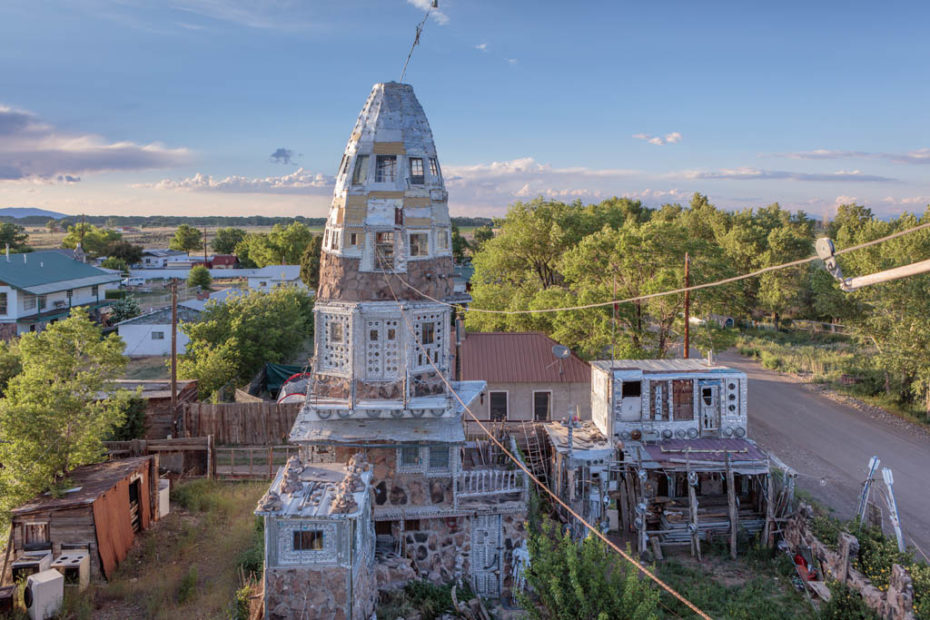
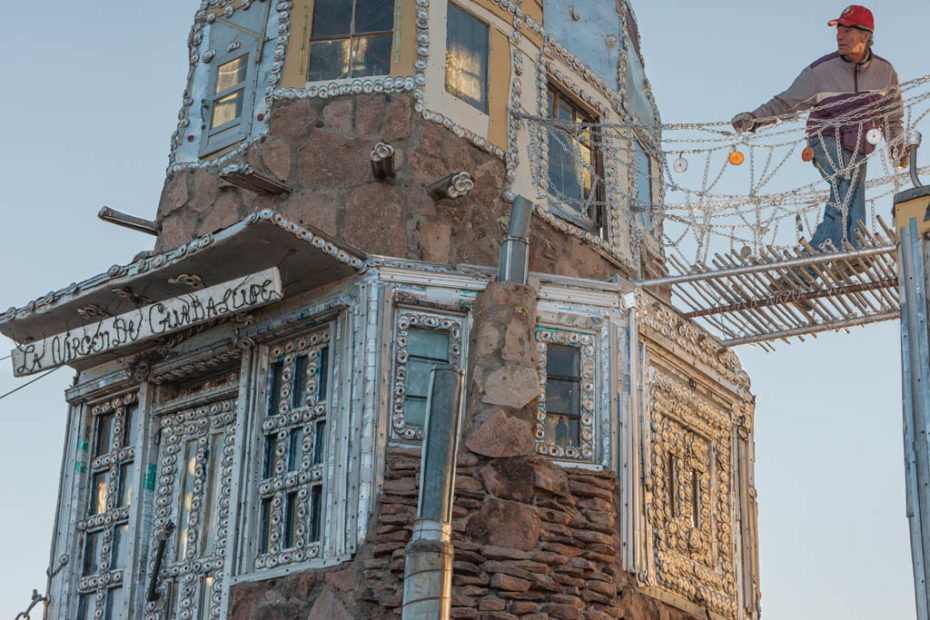
Amid this metallic frenzy are reused wooden windows off all shapes and sizes, religious statues, spiritual inscriptions and trimmings of stacked desert rocks. Over the past 35 years, using nothing but this divine junk, Cano has created a series of linked but distinct structures: the ‘King’ tower, ‘Queen’ tower, the ‘Palace’ and the ‘Rook’. The towers, rising 40 feet high, are like two shiny blades of twinkling tin that cut through the deep blue Colorado sky, the Palace a heap of tin sheets and the Rook clad in shiny silver hubcaps. A multitude of staffs and staves jump up from the yard space, while the walls are liberally draped with scripture texts. The interiors are equally awash with junky artifacts, curtains of colourful plastic cans and window glass of bottles of all types and tints.
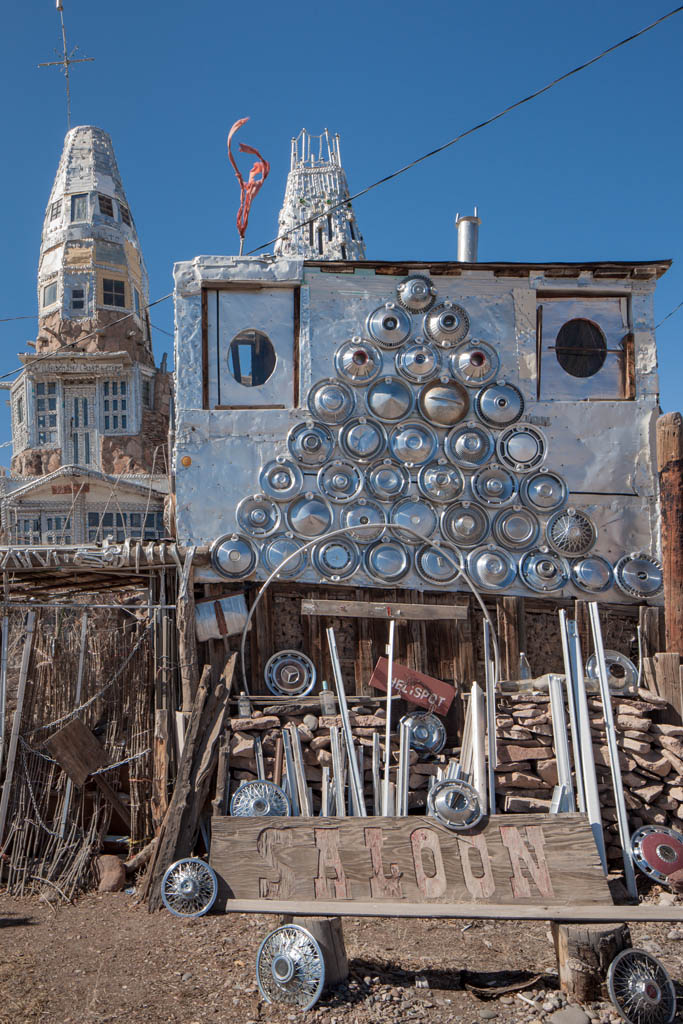
Dominic Cano Espinoza doesn’t smoke or drink, his entire life has been dedicated to this construction service for his God’s House (sometimes seen as the affordable and sustainable Colorado version of Antonio Gaudí’s cathedral, Sagrada Familia in Barcelona).
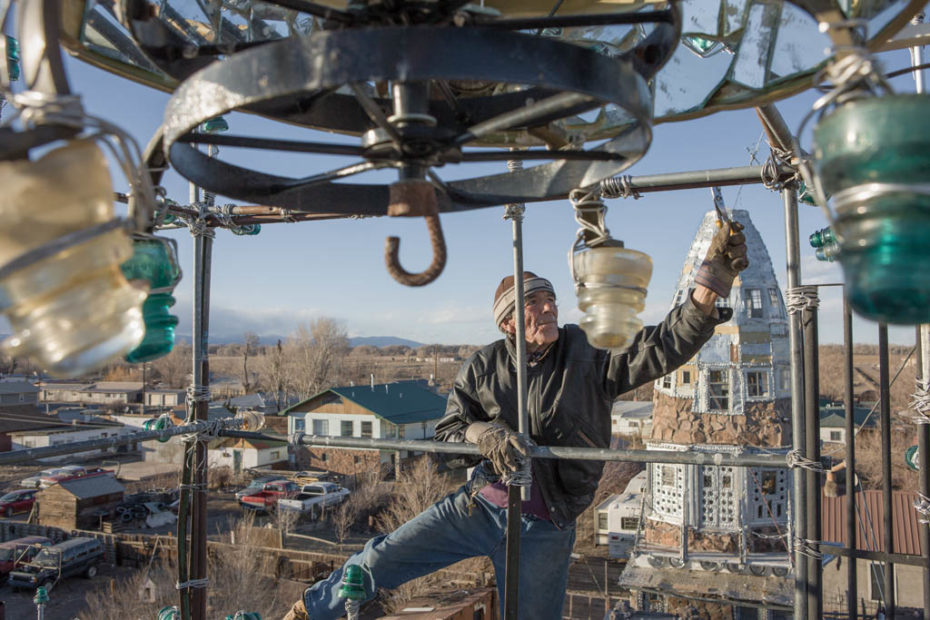
The towers’ silhouettes are strangely reminiscent of two seated bishops in their mitred headgear, perhaps talking to each as to how they ended up in this desert! This house of God is ironically not open to the public, but it is-there to be seen from afar and relays Cano’s message of divine protection through faith.
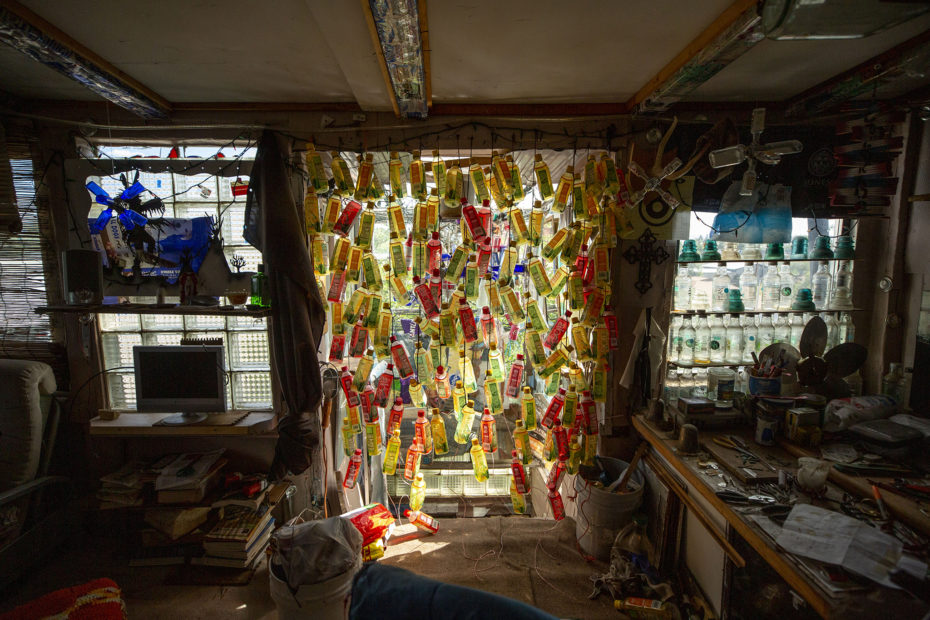
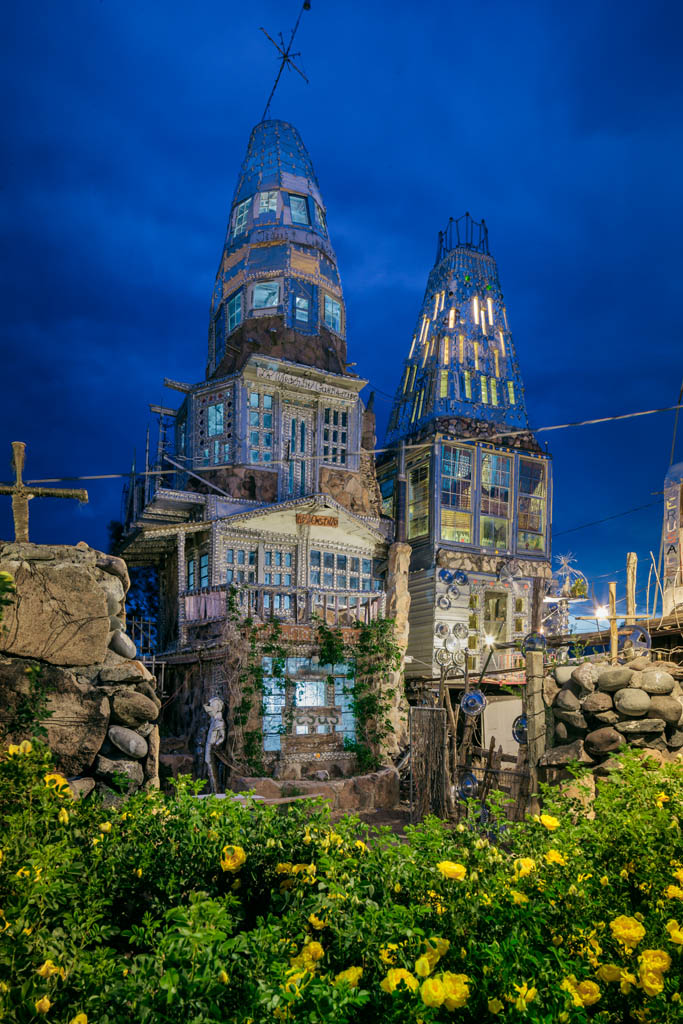
Fred Scruton travels extensively throughout the United States to find, photograph, videotape, and write about artists working outside the mainstreams of contemporary art. See more from his time at Cano’s Castle here.


